TWICE TAKEN PICTURES:
ANCESTRAL PORTRAITS
Photographs by Darryl Sivad
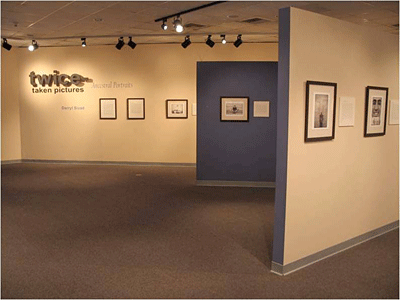
It has been said that history is, not was. In a thoughtful exhibition comprised of portraits of individuals holding the treasured images of family members accompanied by personal narratives, photographer Darryl Sivad captures a present nurtured by the past. Documenting 31 persons from diverse backgrounds and beliefs, "Twice Taken Pictures: Ancestral Portraits by Darryl Sivad," reveals the value that these cherished heirlooms have in their owners' lives. Touching on notions of identity and kinship, loss and immortality, this series explores the profound ties sustained between descendants and ancestors, forming a visual genealogy of those pictured.
Twice Taken Pictures is now available for circulation through 2018. It has been previously displayed at the UCLA Fowler Museum of Cultural History, Los Angeles, CA and the California African American Museum, Los Angeles, CA.
"I refer to these 'twice taken pictures' as 'double exposures,'" writes Sivad. "Initially, I was concerned with the quality of some of the ancestral portraits. Slowly I began to realize that the physical condition of these images wasn't so important. It was the stories they told and the way that the descendants touched, held, and posed with these familial treasures that was important. Photographing descendants with portraits of ancestors became my way of documenting generations."
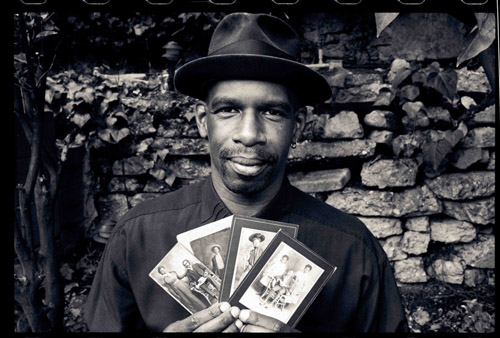
John Freeland, Jr.
Growing up in Connecticut, John Freeland, Jr. knew nothing of the treasures he would years later discover in a brick house. In 1989, when John arrived at the home of his paternal grandmother, Sarah Scott, in Tallahassee, Florida, he was her sole benefactor — the only child of John Henry Freeland, Sr. who was the only child of Sarah. Mourning the loss of his grandmother, John was slow and deliberate in closing up her estate. While cleaning out the drawers of a travel trunk, he found tintypes from the Civil War era. He asked himself, “Who are these people?” Any answers that he wanted he would have to search for because there was no one to call. Precious memories and history lost define this puzzle. Other photos would soon be found in the bedroom with no point of reference. His parents were already deceased and so was his grandmother’s only sister, Clara. “Who were these people who had shaped the lives of those that later had an impact on me? If only there were names, dates or places. Are these hidden treasures about a time that they wanted to forget?” John remembers his grandmother Sarah’s saying, “Hold onto your money.” Had these people been denied their fortunes? Did they have rights that had been denied? If only there was documentation. John is an only child and was never isolated from social contact. But what was and is his connection to his ancestors and these images? |
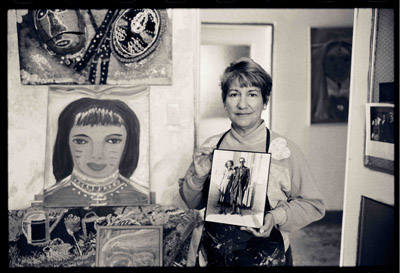
Eddy Bello-Sandoval
Eddy Bello-Sandoval was born in Santa Clara, Cuba, in the province of Als Villas. In 1959, she fled Havana as a political refugee. Eddy’s ancestors had long experienced the need to flee because of their identity. Seen in the photo are Eddy’s parents. Her mother, Eloina Peres, is a first generation Cuban whose parents emigrated from the Spanish-held Canary Islands. Eloina is a Sephardic Jew who did not discuss religion with her daughter. As a child, Eddy was told that she was a Catholic. However, she received educational tutoring from the Yoruba people and eventually adopted their ritual practices. Around the age of twenty-three, Eddy contacted her paternal grandmother’s brother, Dr. Domingo Gomez Güimerañez (a colleague of Albert Einstein), to learn about a photograph that was in her possession. It was then that she learned the history of her father’s family. Ramon Bello-Güimerañez, her father, was a second generation Cuban and a Muslim. His parents were of Moroccan ancestry, and the photo that Eddy was inquiring about was his great-grandmother, Beatrice Bello, of Fulani descent. What made Eddy even more curious about the photo were the markings on her face – Yoruba markings called yeza. Beside Eddy is her painting of that old photograph of Beatrice. |
In this deeply personal documentation of family lineage, these compelling black-and-white portraits reveal the profound meanings family photos can have in our lives. With each portrait, came an outpouring of memories – emotional recollections, reconstructed histories, and poignant anecdotes about beloved family members. Along with the stories and biographies that accompany these representations, their intriguing compositions create powerful moments in each frame.
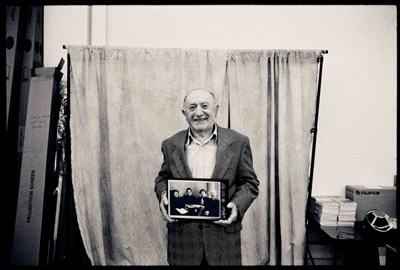
William Herskovic
William Herskovic was born in 1914 five years before part of Hungary became Czechoslovakia. He had known stability and loving family members like those pictured here: his grandmother Sarah Raduziner, an aunt (name unknown), his mother Katarina, and grandfather Mauric Raduziner. William’s mother died when he was a teenager. He began to feel a void in his life and desperately wanted to buy a camera to take up a trade. He wrote to an uncle in Nebraska who sent money for his first camera. He began working as a photography apprentice and years later moved to Antwerp, Belgium, where he opened “Studio Willy.” One day in 1942, a drunk Nazi soldier he was photographing mistakenly confided that Hitler planned to invade Belgium. Being Jewish, William decided to flee with his wife Esther and their daughters Katie and Germaine. Shortly thereafter, they were captured, separated, and sent to hard labor camps. The constant image of his wife and crying children made him desperate to escape. In Peiskretchan, William formed a team, and one night during a hailstorm they crept through a fence. After many narrow escapes and with many allies, the men made it to safety. William tried to rescue his wife and daughters from Auschwitz but was unsuccessful. His eyewitness account of the conditions in the Nazi extermination camps was the first to reach Belgium. He reported that people were not being taken to work camps but to death camps. William later married Esther’s sister, Maria, whosehusband was also killed in the Jewish Holocaust. Maria fortified William’s life again with love. Together they have three daughters. In 1957, the family moved to the United States. William and Maria opened Bel Air Camera in Westwood, California. Today it is one of the most successful photography stores in the area. |
Photographer Darryl Sivad credits his wife, M. Rochelle Sivad, with helping him find the idea for this kind of photographic genealogy, which began with a portrait sitting of Rochelle's great-grandmother who happened to have an old photograph of her own grandmother on the wall behind her. That moment seemed to give new life to their heirloom picture and inspired the subsequent series. The accompanying narratives, written by M. Rochelle Sivad and Darryl Sivad, are derived from their lengthy interviews with the sitters.
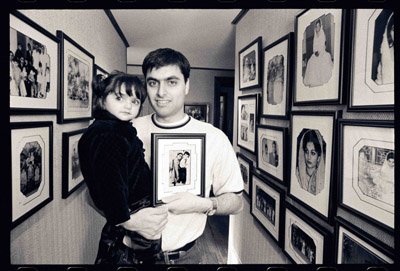
Suliman Muhammad
After the holy month of Ramadan, the Muslim world has a holiday known as Eid Al- Fitr. During that time, many friends and families gather together to celebrate. My wife and I have attended dinners at the Adaya estate. The Adayas are parents of our friend Ruksana Muhammad. One year I noticed a hallway in their home with lots of photos on display. I realized that it was the perfect place to photograph Ruksana’s middle son, Suliman Muhammad, and his oldest daughter, Marwa. He holds a sixty-year old portrait of his grandmother, Amina Adaya (seen in the suspenders) with her cousin Zubaida. It was taken in the five hundred-year old village of Bantva, which is a twenty-four-hour train ride from Bombay, India. This village is where Suliman’s lineage began. Suliman shares with us that as an adult it’s been hard to imagine his grandparents as children. However, it helps to have these photos displayed in the hallway. They date from the early 1930s to the present and help him thread together a story of their lives. This enables him to more vividly see the history and know from where they came. |
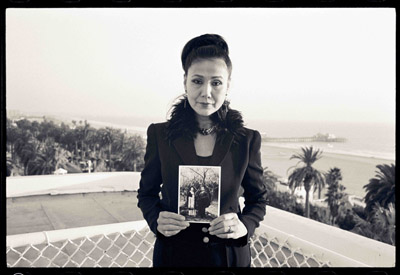
Ritsuko Kai
I arrived in New York City around 1975 to apprentice as a photographic assistant. During that time, I would go to the international newsstands and pick up European publications. I was influenced by the photographic trends coming out of Paris and Milan. I first saw Ritsuko in a French Vogue fashion spread for Givenchy. It was her elegance and sophistication that caught my attention. As fate would have it, many years later our families met and became friends. This is Ritsuko’s story — as a little girl, she grew up on the land that her family had owned for more than 480 years in Japan. The house itself had been re-developed over time. Her mother was a beautiful woman, who raised four children, and her father was a sculptor. The picture she’s presenting is of her parents, Risaburo and Tome Nakamura, who are in a cherry blossom garden on their honeymoon. Ritsuko grew up and garnered the honor of Queen of the Pacific. She then became first runner-up of the Miss Universe contest after which she traveled to Australia and entered the World Modeling contest. There she won a coveted contract with the Eileen Ford Modeling Agency. She then moved to New York City and was the first Japanese woman in America to become a super model. Now a dedicated wife and mother, Ritsuko has a daughter attending Princeton University and a son in a magnet junior high school. When not partnering with her dedicated husband on projects, she works for a very well known designer in Beverly Hills. |
Darryl Sivad has been a commercial and fine art photographer since 1975. His images are in the permanent collections of the Smithsonian Anacostia and the Museum of the African Diaspora. His work has been featured in publications and toured in exhibitions including "Reflections in Black: A History of African American Photographers 1840 to Present," organized and circulated by the Smithsonian Institution. Sivad is a film and television actor who has appeared alongside Barbara Streisand, Will Smith, Tea Leoni, Charlie Sheen, Seth Rogan, and others.
_________________________________________________
Exhibition Information
Contents: |
31 photographs -19 x 22" framed,
11 x 14" iris prints,
plus extended label copy and 2 framed text panels |
| Space Req: |
150 – 200 running feet approx. |
| Dates Avail: |
2016 - 2018 |
| Loan Fee: |
On request |
| Insurance: |
Exhibitor responsible |
| Shipping: |
Exhibitor responsible |
Req: |
Appropriate security |
| Contact: |
Photographic Traveling Exhibitions
E-mail: info@p-t-e.org
Tel: 310 397 3098 |
|




